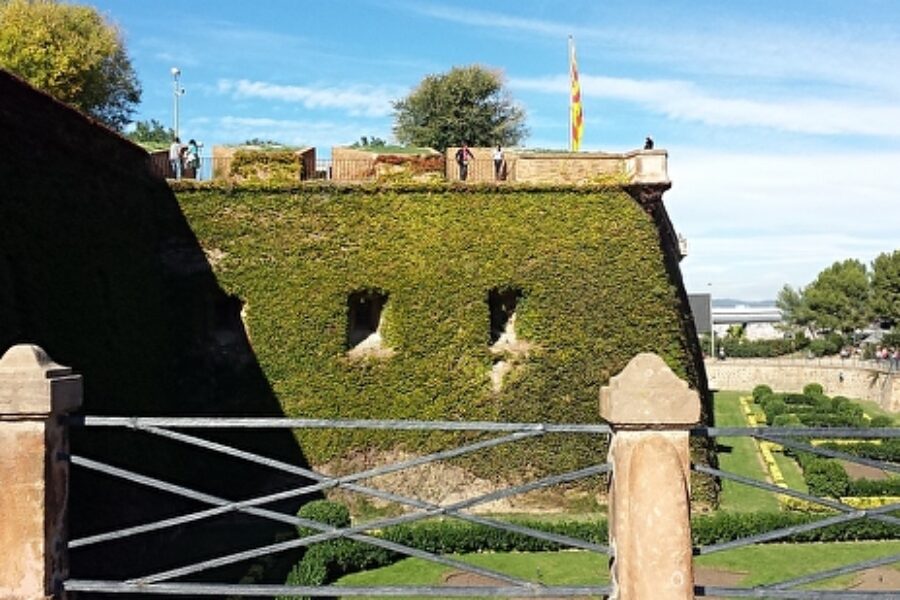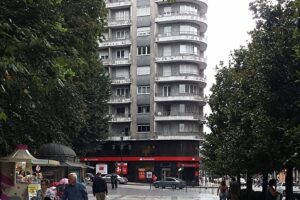Castle Montjuic
I guess, ultimately, it is all Kroger’s fault that we find ourselves climbing higher and further than endurance allows. This grocery store in my daughter’s neighborhood in North Dallas is where I first discovered and purchased the paperback book, Angel’s Game, by the Spaniard Carlos Ruiz Zafón. I enjoyed it so much it led to another book, Shadow of the Wind, which led to another book, The Prisoner of Heaven, all by the same author, all set in Barcelona with the malevolent image of Castle Montjuic looming over the city. Our mountain top tour of Castle Montjuic begins at 1 pm.
A Mountain Too High

As we climb the steps Michael asks, “What is our window?”
Almost all reservations and tickets to attractions in Barcelona have an extended window of time. “There is no window,” I say, “we have to be there at 1 p.m.”

I feel we have climbed a thousand steps as we crest the hill to a curving road, seeing a line of people waiting for their chance to ride a glass bubble to the top of Montjuic. We take our place at the end of the long line, thinking our Barcelona ATM card will gain us access. Too late, we find we are wrong. We need to go back to the entrance, get in another line, purchase tickets, and then get back in line to ascend. Checking his watch, Michael feels we have already wasted too much precious time. We can’t waste more. There is no choice but to retrace our steps, going down, just so we can continue the tortuous climb up. On foot.
“I’m not sure I can make it,” I say as we race against the clock. Putting one foot in front of the other, I follow Michael’s back as on his journey upward.
The Tour
Because of my online ticket purchase, we gain immediate entry, passing the long lines outside. Barely on time—with only five minutes to spare—we listen to instructions on how to proceed; walk through the exterior castle walls, turn right, walk up the hill, and at the top of the passageway we need to climb some more steps, then enter through the door under the castle tower. We take the very long way around the castle walls heading for the only tower we see. The wrong tower. We backtrack. Trying again. This is our M.O.


Standing here, I count seven other people gathered for the tour—the only individuals on this mountaintop who may walk within the rooms and halls, nooks and crannies, towers and dungeons, of this old fort, turned castle, turned fort. After reading three books in the dark of night, imagining its menace, I want to see it all.




After a hard hour of climbing, we continue on, our knees and lungs and thumping heart, facing the torture of more stairs.
Up and down and up again and down and up and ultimately—there is a tower. When we enter the tower the thing that excites me most is that I don’t see any stairs. Then our guide opens a door—only sixty steps to the top she says.


Pura Brasa and Lunch
An hour and a half later, all Michael and I want to do is find a bench and sit. We discover a bus stop just outside the castle walls. Unfortunately, we have to stand and wait. When the first bus pulls up, we decide to board. We have no idea where it goes, but wherever it is, that is our destination. The air is cool, and two seats are empty.
Leaving the bus at Placa d’Espanya, we head toward the metro and home. As we head to the underground, a sign distracts us with claims that the best Mexican food in Barcelona is within our reach. The arrow points down. We follow the arrows and take a seat in the crowded restaurant filled with Saturday revelers. Shoppers. When finally our order is taken, the first thing we choose is, “Finished.” Nada. We find another interesting menu item. “Finished,” we are told. Quickly adapting, we choose something else. “Finished.”
“Let’s leave,” Michael says.
Our stomachs still rumbling, we choose Pura Brasa, just around the corner. Eating al fresco seems the thing to do, and we join a multitude of couples sitting at the sidewalk tables. However, the wait staff seems to ignore everyone sitting at an outside table. We try inside. After a meter of ribs (only a third of a meter—they lied) and a liter of sangria, we head home. By the time we tumble into bed—early tonight—Michael’s FitBit tells us we have climbed almost 70 flights of steps and walked close to six miles, even though we rode the Metro to and from home. We may sleep in tomorrow.

Historical Note:
With roots dating back to the 1600’s, in the last 350 years Montjuic Castle has played a decisive role in the history of Barcelona becoming a symbol of submission after the Catalan defeat to Spain in 1714. Since then the Montjuïc canons bombarded the city and its citizens on various occasions and Montjuïc has been used as a prison and torture center repeatedly for three centuries.
The castle is infamous in Catalan history books because of its role in the Spanish Civil War from 1936 to ’39 when both sides of the conflict imprisoned, tortured and shot political prisoners. Among these unfortunate individuals was Lluís Companys, the president of the Generalitat de Catalunya at the time, who was executed by the dictator Franco’s regime in 1940.
The Francoists took control of Spain through a comprehensive and methodical war of attrition which involved the imprisonment and executions of Spaniards found guilty of supporting the values promoted by the Republic: regional autonomy, liberal or social democracy, free elections, and women’s rights, including the vote. The rightists considered these “enemy elements” to comprise an “anti-Spain” that was the product of Bolsheviks and a “Judeo-Masonic conspiracy. At the end of the Spanish Civil War, according to the regime’s own figures, there were more than 270,000 men and women held in prisons, and some 500,000 had fled into exile.
Large numbers of those captured were returned to Spain or interned in Nazi concentration camps as stateless enemies. It has been estimated that more than 200,000 Spaniards died in the first years of the dictatorship, from 1940–42, as a result of political repression, hunger, and disease related to the conflict. The lowest estimates of the number of executions during the first five years after the war are of 50,000.
Carlos Ruiz Zafon
Read his books! they will keep you up at night. Then go to Barcelona!









Leave a Reply
Your email is safe with us.